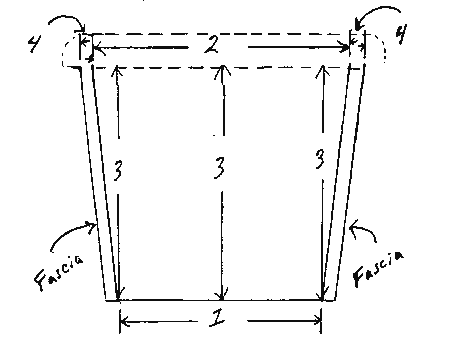
Please print these instructions out for easy reference while you measure your screens.
Directions for Measuring Your Horizontal Companionway Opening

On most boats it is bit easier to measure the horizontal opening than it is the vertical opening. It can be more complicated, however, to determine where and how the top screen will fit properly. Once this is determined, however, the measuring is relatively easy. Our horizontal companionway screens are designed to rest on the raised fiberglass ribs or metal tracks on which most companionway tops slide back and forth, or on the wood trim located inside and below the tracks. Each has different dimensions and the screens themselves are built somewhat differently for each location as you have seen from the description of the this screen. You will need to determine which location will best enable the screen to fit snugly against both the face of the top slide and the vertical screen. The instructions below should help you determine where the screen needs to go and how to take the measurements necessary for us to custom-build your top companionway screen.
1) Standing in front of the companionway and with the dropboards in place, push the top slide forward and look to see if you have wood trim on the sides of the opening below the slider track. If you do, pull the top slide back until it is 2 inches away from the top companionway board. Now imagine that you place a piece of wood 2" wide and 3/4" thick across the companionway opening and resting on the trim. (I'm assuming you don't have a 3/4" piece of wood the exact length you need for this.) Would this piece of wood completely seal off the companionway, touching the inside of the top board and the face of the slide along the entire length? If yes, check the "Screen on Trim" block on the left side of the top screen diagram and skip to # 3.
2) If there is no trim ,again pull the top slide back until it is 2 inches from the dropboards. This time imagine you are placing a 2" wide but only 3/8" thick piece of wood across the opening and resting on the slider tracks. (The screen will still be 3/4" thick but the lips on the side are 3/8" thick.) Would this piece of wood completely seal off the companionway, touching the face of the top slide along its entire length and either touching the inside face of the top board or resting on top of the board? If yes check the "Screen on Slide" block on the right side of the top screen diagram. If either of these two designs will not work for your boat's companionway, please use this diagram to illustrate your companionway. We will make every attempt to figure out a design.
3) Push the slider back as far as it will go and then pull it back out about an inch. Measure the distance from the face of the slide to the inside face of the top companionway board on both the port and starboard sides and write these measurements on the side of the diagram under the type of screen you need.
4) Screen on Trim Style Only- Measure the width of the opening from the fiberglass on one side just above the trim to the other. Measure this in several places and write down the narrowest width on Line #4 on your side of the diagram.
5) Screen on Slide Style Only- Measure the width of the opening from one inside edge of the fiberglass rib or track to the other inside edge. Measure in several places and write down the narrowest width on Line #5 on your side of the diagram.
6) One final note. Most of the difficulties in getting this screen to fit properly (meaning no gaps) involve the face of the slider. Anything that sticks out from the lower section of the face may present a problem, especially when the screen rests on the slider as this design generally rests higher up against the face of the slider. The hasp for locks and manufacturers' nameplates are but two common examples. Both can be accommodated but we need to know about them. Please give us as much information as possible and feel free to draw or make notes on the diagram.